Imagine a garden filled with the tropical fragrance and vibrant colours of frangipani flowers—all grown from simple cuttings. Growing frangipanis this way is easier than you might think. Today I want to talk about how to plant frangipani cuttings and propagate them successfully.
Where I live in Australia, frangipanis are everywhere. It’s common to see trimmed branches left on the side of the road for collection. On my walks, I often pick up these discarded trimmings and grow new frangipanis in my yard. Over time, I’ve had great success growing them this way, and you can too.
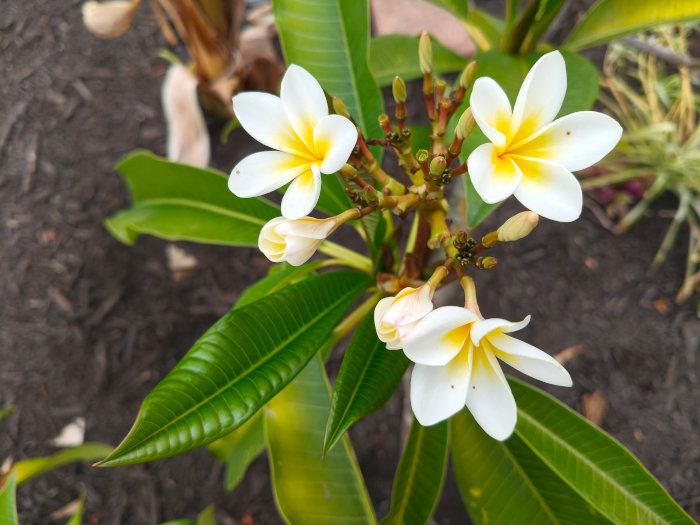
How to Grow Frangipanis from a Cutting
Frangipanis are incredibly easy to propagate from cuttings, as you can take a cutting from nearly any part of the plant and simply stick it in the ground for it to grow. The success of the cutting isn’t limited by its size; you can even propagate entire branches.
These plants are super hardy, and I’ve had a lot of success using cuttings that were left on the roadside for weeks before being planted.

Materials Needed
- Knife/Pruner – Whenever cutting plants, using alcohol to sterilize tools is good practice to avoid spreading disease.
- Rooting Hormone(optional) – The base of the stem can be dipped in rooting hormone to increase the chances of roots growing but you can succeed without it.
Step 1: Take a Cutting
Before taking a cutting, ensure the mother plant is healthy and free of any diseases. Frangipanis barely get any diseases so you will probably be good to go with any cutting you find or take.
- Smaller cuttings are easier to manage and care for during the rooting process.
- Larger cuttings provide more established growth and shape, helping you achieve a mature-looking plant faster.
The main thing with large cuttings is to give it enough water until the roots develop, at least twice a week, more in very hot weather.
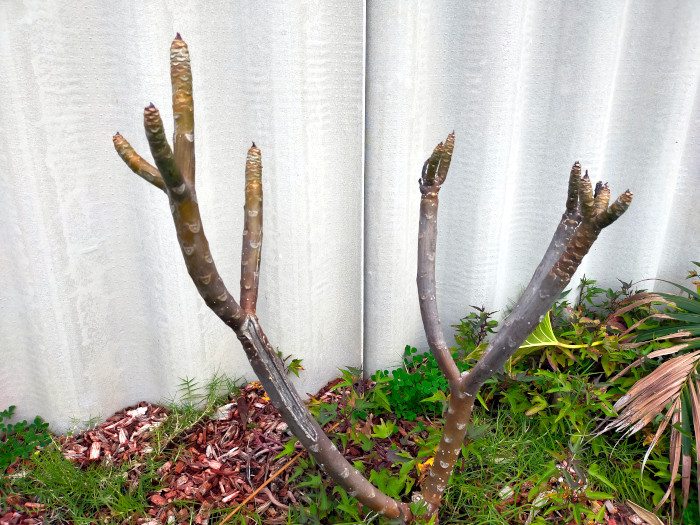
How to Cut
When taking a frangipani cutting, make the cut just below a node—the point where a leaf or branch joins the stem. This is where new roots are most likely to form, increasing your chances of success.
Cutting at a 40-degree angle also helps reduce the risk of water seeping into the wound and causing rot.
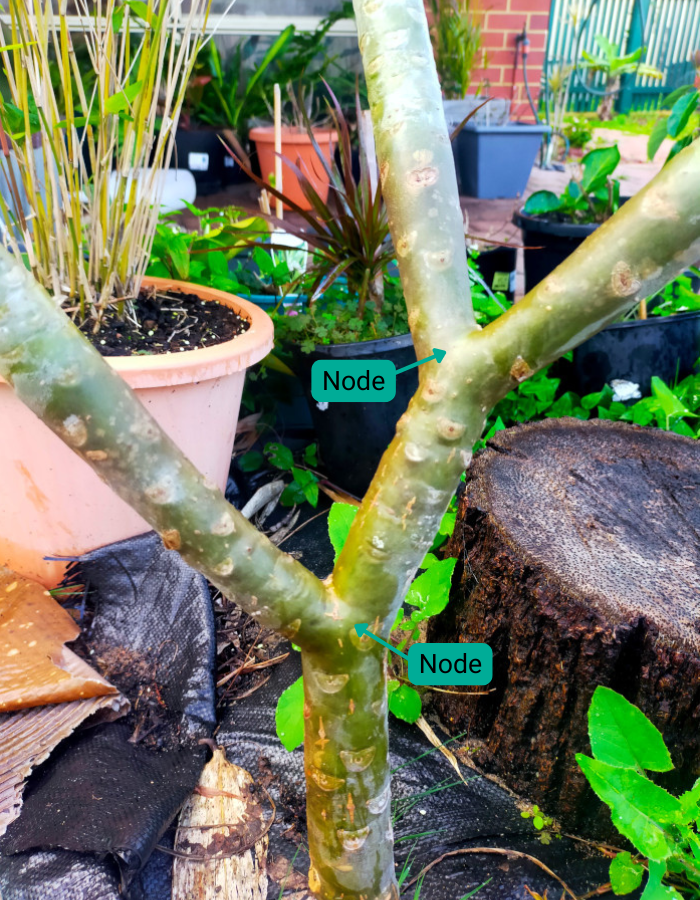
For larger branches, include a good amount of stem in your cut. This helps anchor the cutting until it grows roots. If the branch is particularly big, I like to stake it into the ground for extra support as they tend to fall over.
Frangipanis naturally shed their leaves, so don’t worry if your cutting ends up looking like a stick. As long as new buds appear at the top of your cutting after a few weeks, you are on the path to success.
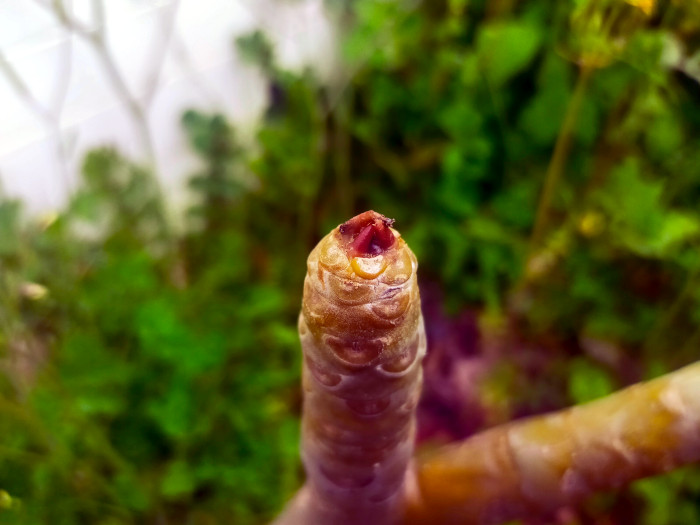
Step 2: Prepare Cutting
Take your cutting and let it sit for around 10 minutes while the cut wound scabs over and dries. This will help prevent the stem from rotting. At this point you can dip the bottom of the cutting in rooting hormone if you wish.
Step 3: Plant Cutting in Soil
You can plant the cutting directly in the ground or in a pot and keep it in a bright location. Frangipanis love lots of light, and direct sun is okay for a cutting. They prefer free-draining soil and don’t need much in the way of nutrients—they grow well in the sandy soils we get here in Perth.

If your cutting is a larger branch, be sure to tie it to a stake, as it will blow over in the wind otherwise.
For the best results, use good quality soil or potting mix. This will help retain moisture, making it easier to keep the cutting hydrated.

You can also use compost if you have some available. Sprinkle a few handfuls around the base of the plant, especially if you’re planting it directly in your yard and following a no-dig approach. Once the cutting is planted, give it a good soaking to help prevent it from drying out.
Step 4: Monitor and Care
It usually takes a few months for a Frangipani to develop roots. You’ll know the cutting has rooted when you see new leaf growth or when you feel resistance if you gently tug on the cutting. Frangipanis, in general, have very small root systems, so my advice is to simply wait until you see buds and leaves starting to grow.
Water your cutting twice a week or so, as long as the soil doesn’t become too soggy. If you’ve chosen larger branches, you’ll need to water more often in hot weather. I like to hand water branches every day when the temperature goes over 34°C (93.2°F)—that’s just my rule—otherwise, the cuttings will dry out.
They can sometimes look dead when they are just a stick in the ground but be patient and you will most likely see them spring to life eventually.
If you grew your cutting in a pot, it’s a good idea to repot it into a larger pot as it matures, as this allows for more root development and gives the plant the space it needs to thrive
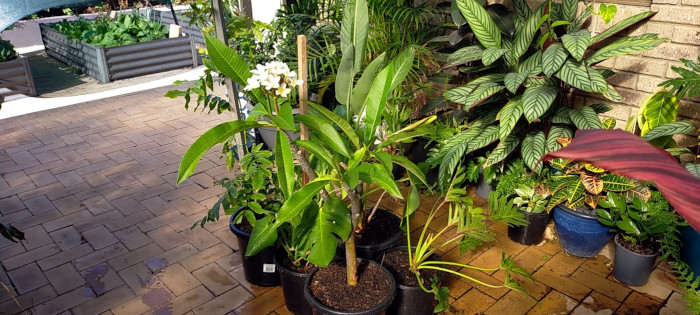
How to Grow Frangipanis from Seeds
Growing frangipanis from seeds is going to be a much slower process than from cuttings, as they can take a few years to reach maturity and start flowering. But you might get some cool varieties out of it so here is how to do it:
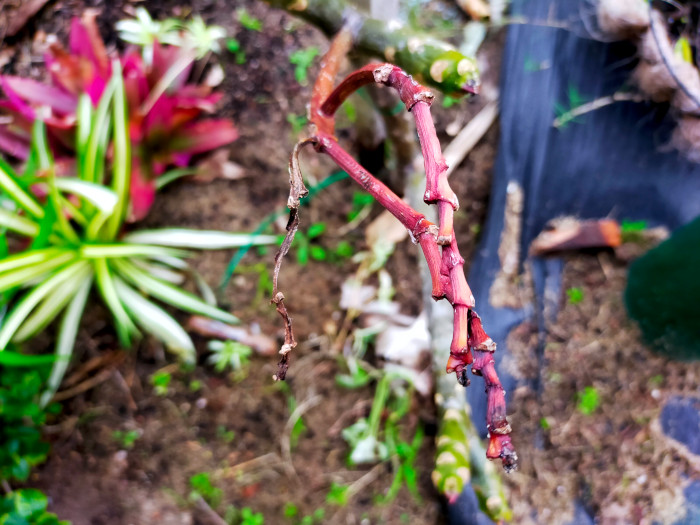
Materials Needed
- Frangipani Seeds: You might be able to get these online or collect from seed pods on a mature frangipani tree. Fresh seeds will germinate better but older ones will work too.
- Seedling Tray or Small Pots: Use small containers with drainage holes for starting seeds.
- Free-Draining Potting Mix: A light, sandy, or cactus mix works well to prevent waterlogging.
- Plastic Cover or Humidity Dome (Optional): This helps maintain humidity, aiding in seed germination. Fairly useful if your in a very dry area.
Step 1: Sow the Seeds
Fill your seedling tray or small pots with the free-draining potting mix. Place the frangipani seeds on the surface, ensuring they are spaced out. Lightly press them into the soil but not too deep.
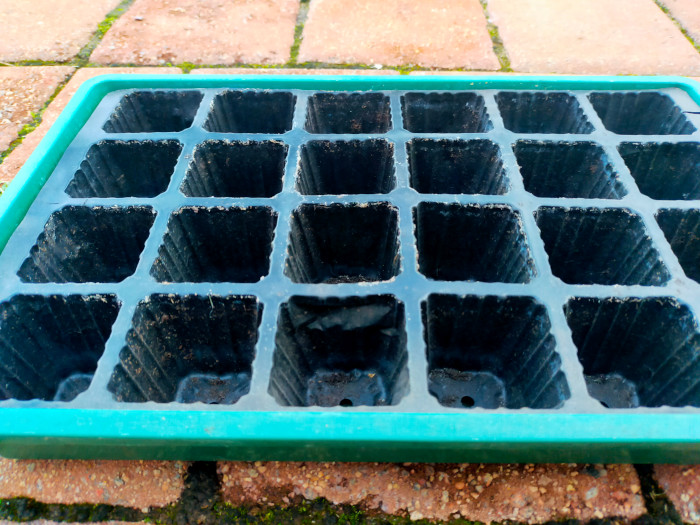
Step 2: Water
Lightly water the seeds to moisten the soil without making it soggy. If you have a plastic cover or humidity dome, place it over the tray or pots to help retain moisture and warmth, which will speed up germination and prevent the seeds drying out.

Step 3: Give Light
Place the seed tray or pots in a warm, bright location. Frangipani seeds germinate best in temperatures around 24-29°C (75-85°F). If you have a very hot, harsh climate, putting them in a spot with afternoon shade is a good idea.
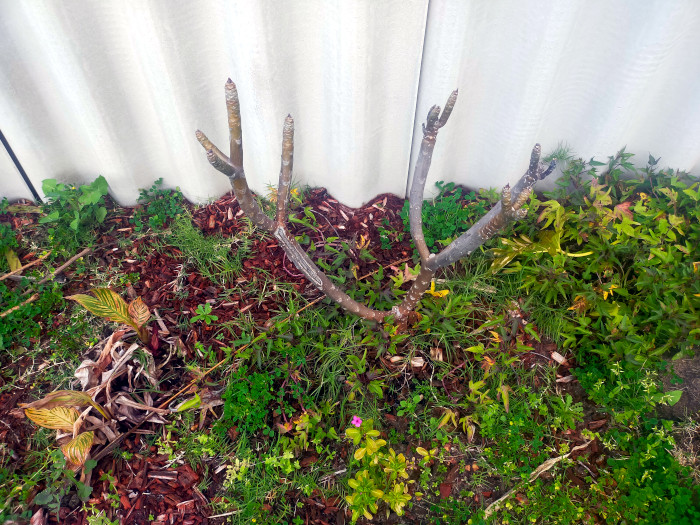
Step 4: Monitor and Transplant
Germination can take anywhere from 1-3 weeks. Keep the soil slightly moist during this period, but avoid overwatering. Once the seedlings have developed a few sets of leaves and are sturdy enough to handle, you can transplant them into larger pots or directly into the ground.
FAQ
Can You Grow Frangipani in Pots?
Yes, frangipanis grow well in pots and can become quite large even when planted in smaller containers. If you keep them in pots, make sure the potting mix is free-draining to prevent waterlogging, as frangipanis are susceptible to root rot. Choose a pot with drainage holes to ensure excess water can escape.
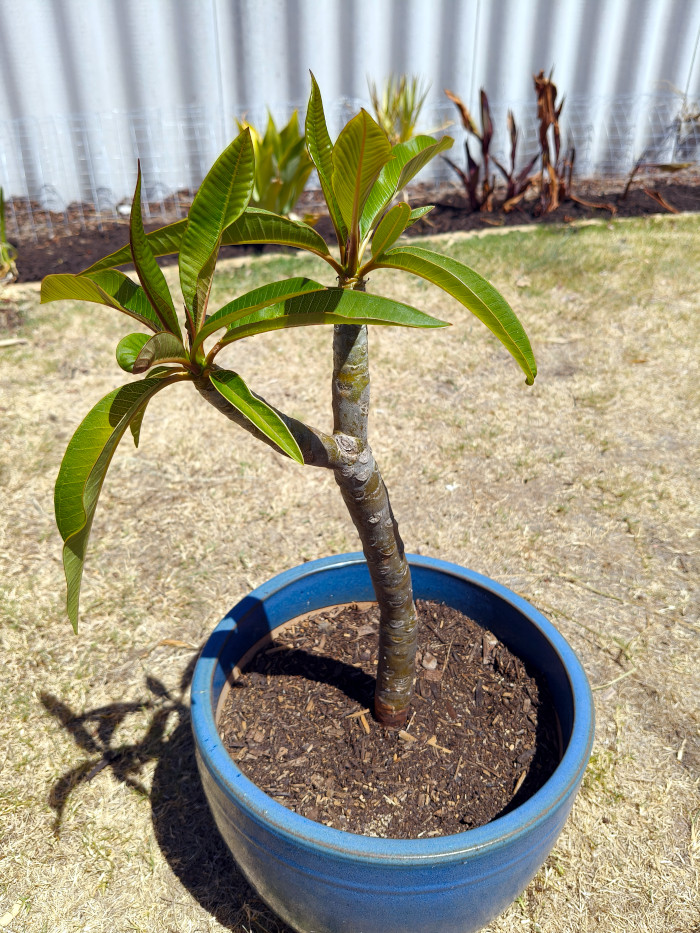
Can You Grow Frangipani Indoors?
Frangipanis can be grown indoors, but getting them to flower can be challenging since they naturally thrive in bright, direct sunlight. If you’re keeping them indoors, place them in the brightest spot possible to maximize their light exposure.
If you don’t have access to strong natural light, consider using a grow light to encourage flowering.
They prefer to dry out slightly between waterings and are very drought tolerant in general, so be cautious not to overwater.
How Big do Frangipani Trees Grow?
Frangipanis can grow quite large, reaching around 8 meters (26 ft) tall, but there are smaller varieties available that can grow only 1-2 meters (3-6 ft). They also grow very slowly, so if you have a smaller plant indoors, it’s not going to outgrow your room anytime soon.
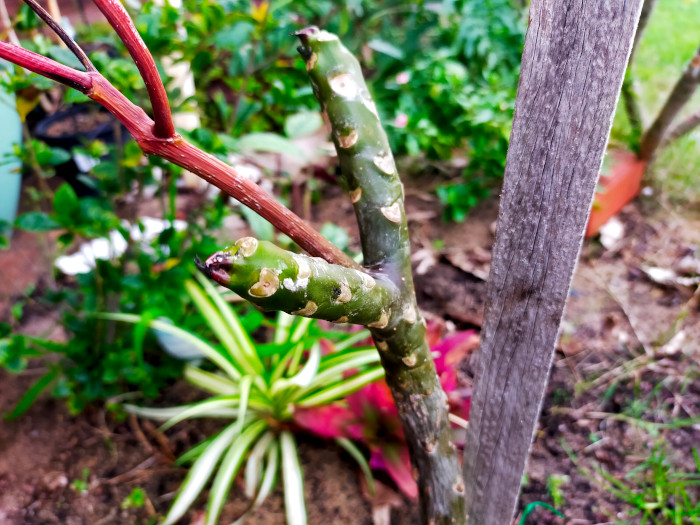
Frangipanis can have a broad canopy spread, sometimes reaching around 3-4 meters (10-13 feet) wide, so they are good as shade trees. Regular pruning can help manage their size and promote bushier growth.
How Big Can a Frangipani Cutting Be?
You can take a cutting of any size, from a small piece to an entire branch, and be successful with either. A small cutting will be easier to care for but will take a long time (years) to get any significant size.
Branches will give you a fuller look much faster, but they’re more susceptible to drying out before they grow roots. So, you’ll need to water them more often, especially in hot weather. Since they have no root ball, you will need to stake them until they grow roots, otherwise they will fall over easily.
Conclusion
I’m a big fan of frangipanis, both for their nice scent and delicate, beautiful flowers. Propagating frangipanis from cuttings is a straightforward and easy process which can give you a larger plant quickly. With their hardy nature and adaptability to various conditions, these plants make a good low maintenance addition to the garden.
So why not get started? Find some healthy plants to get cuttings from and start your frangipani propagation today. You will have a lush tropical garden in no time.
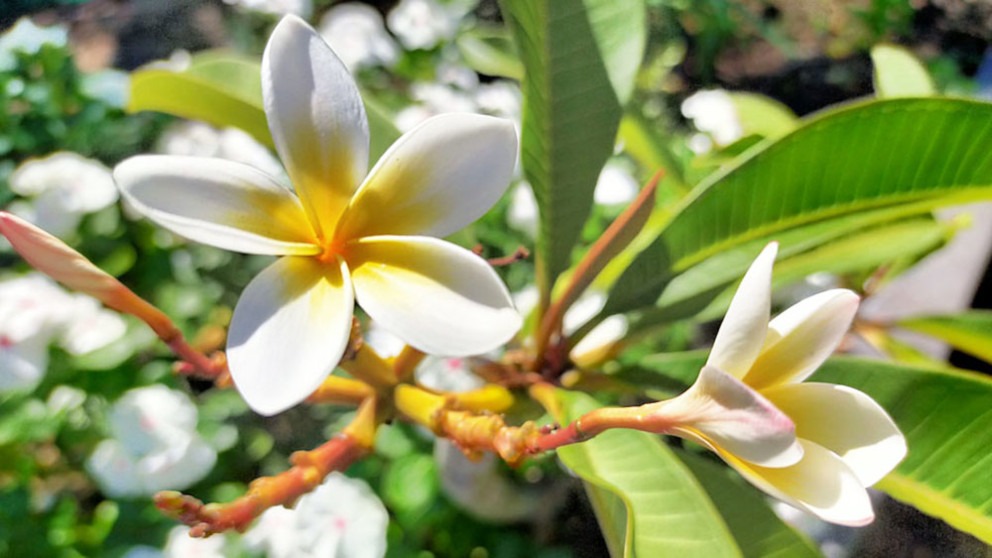



EXCELLENT article! Lots of detail, relevant photos, no pets or kids.
THANK YOU!